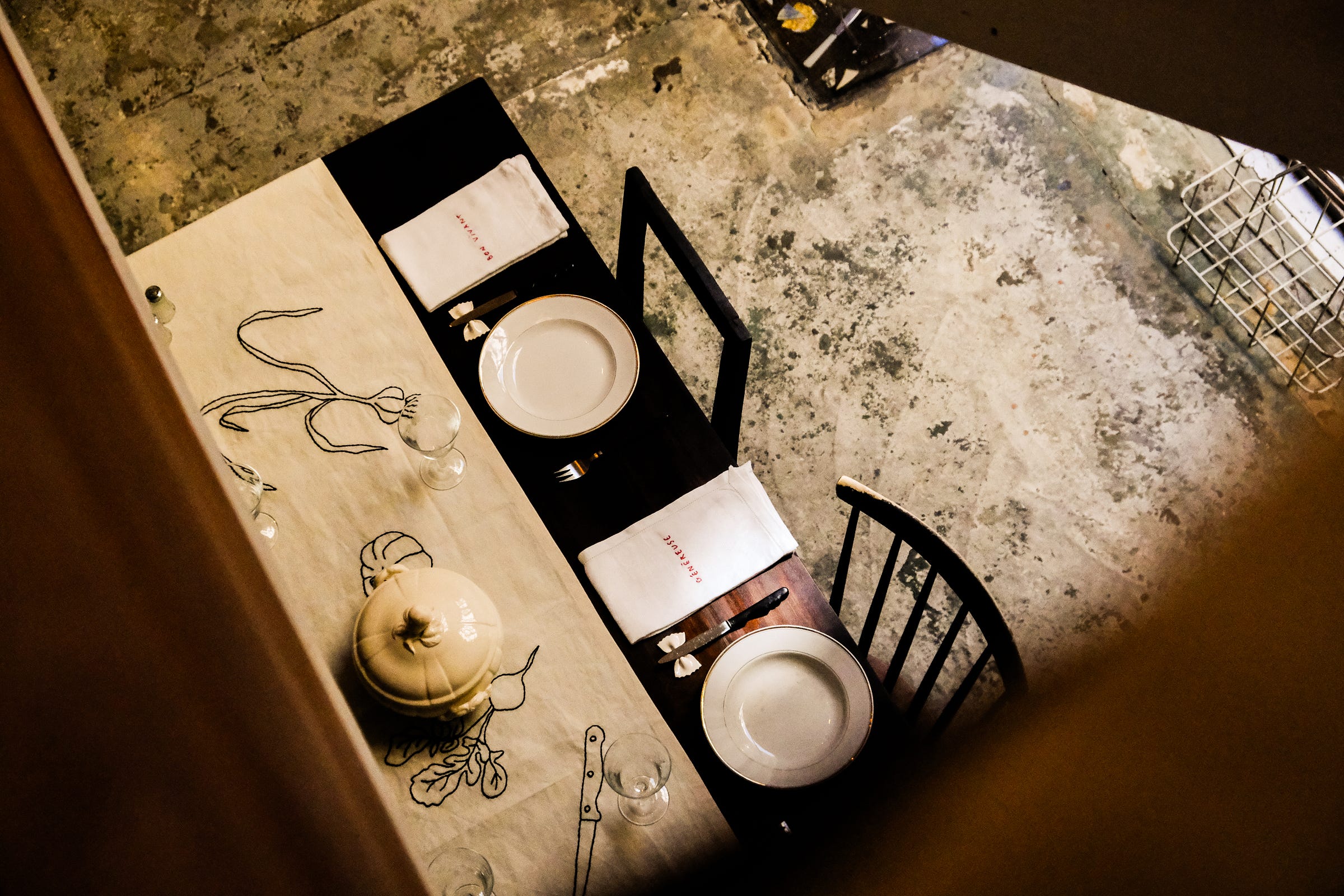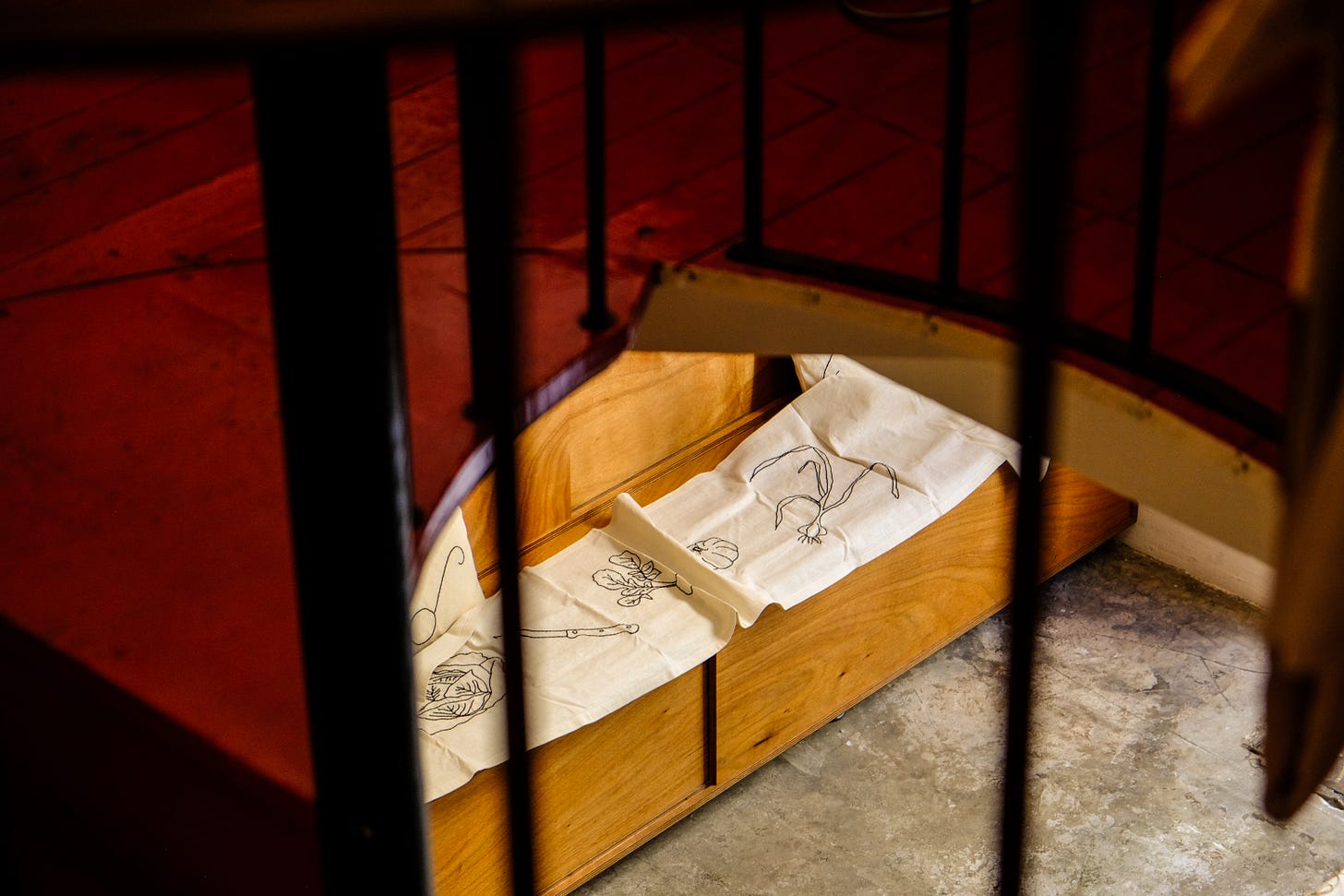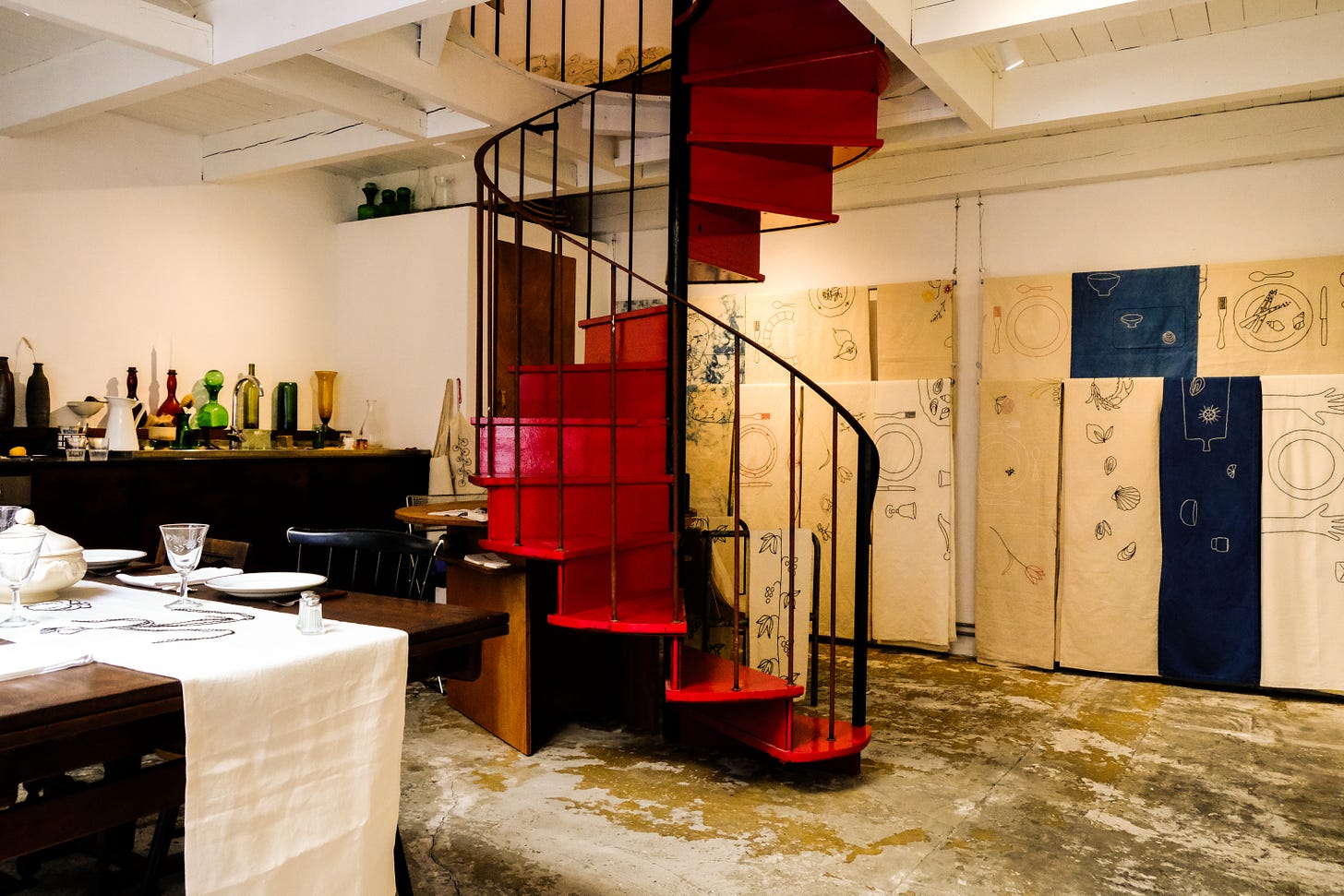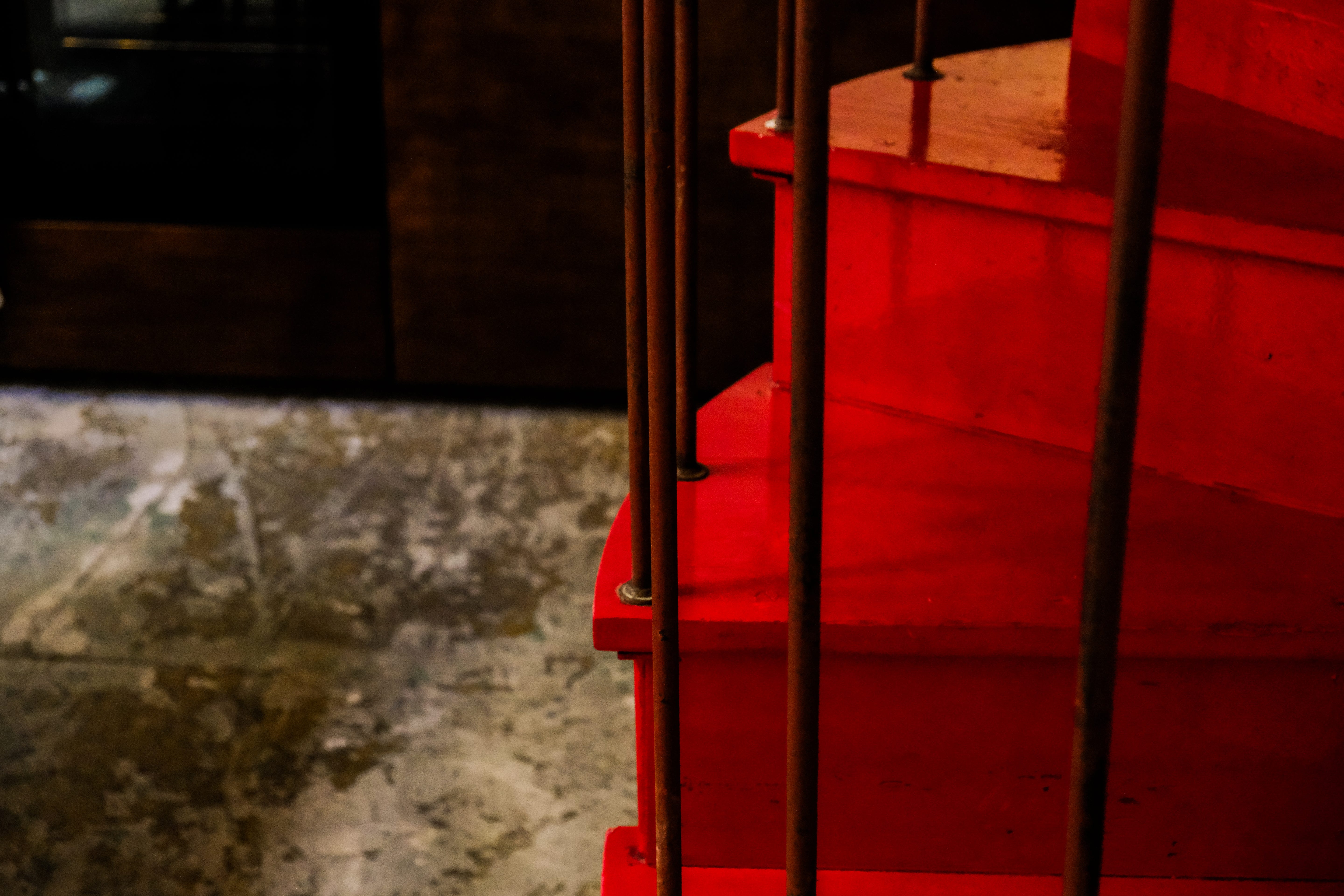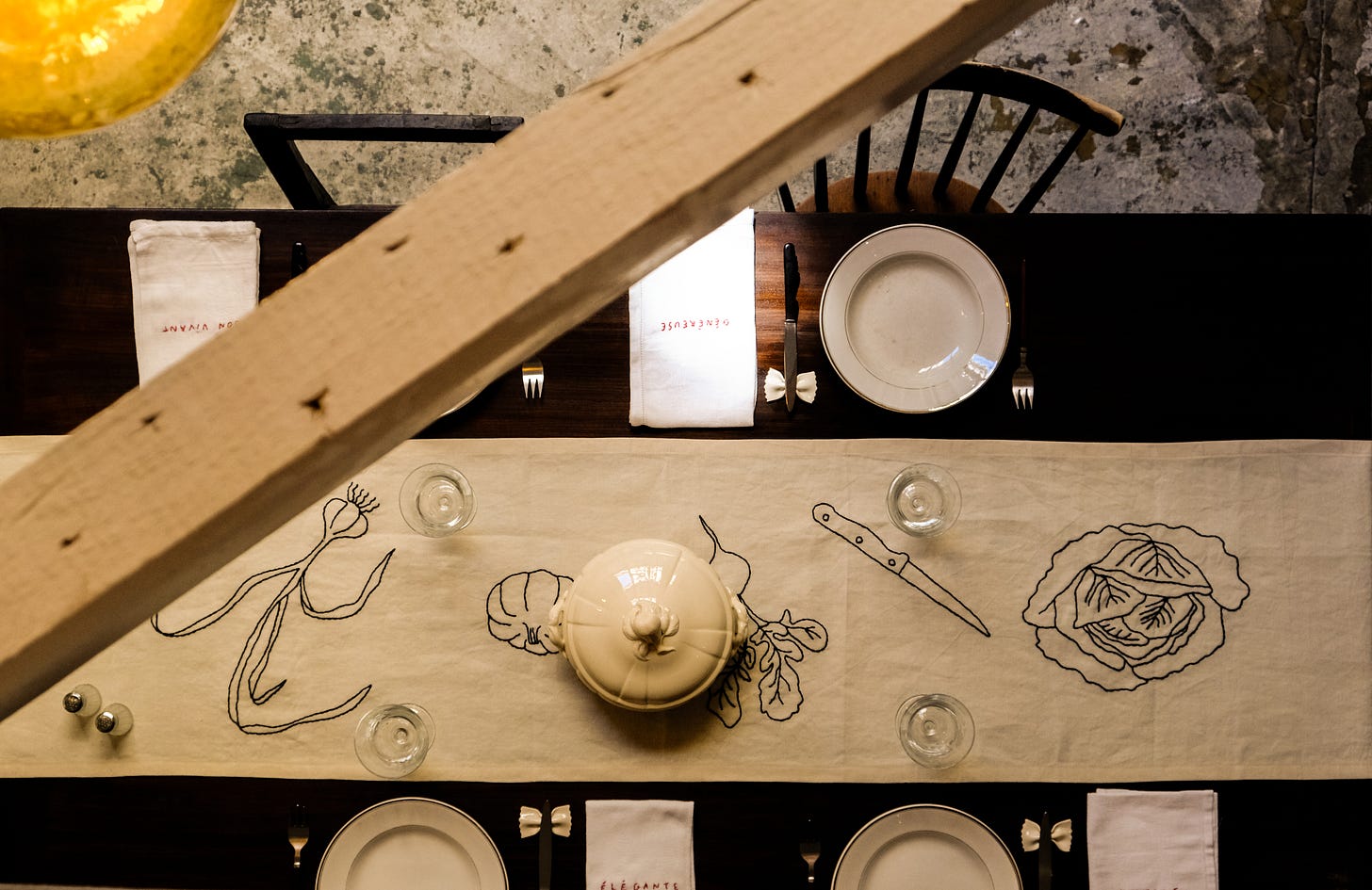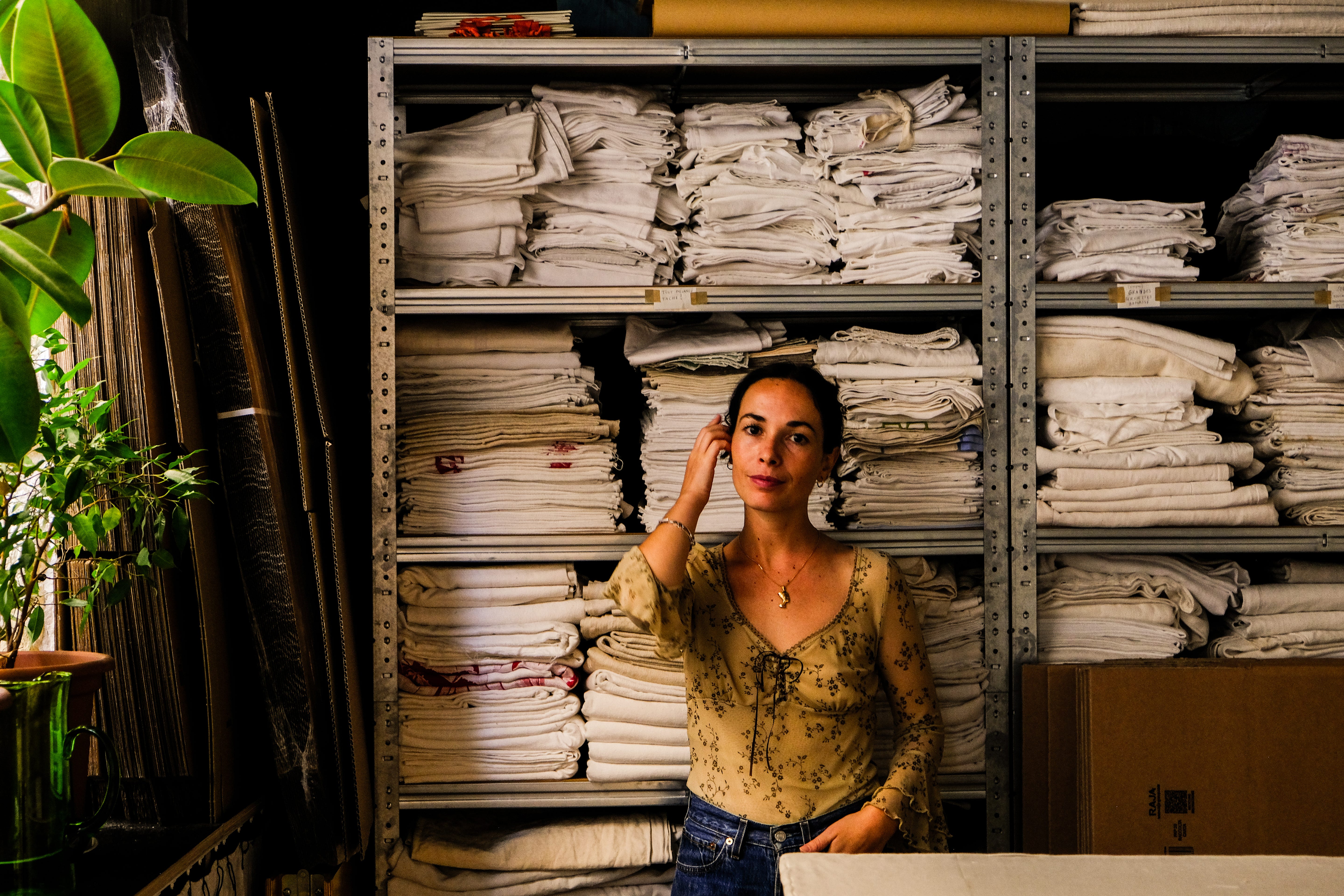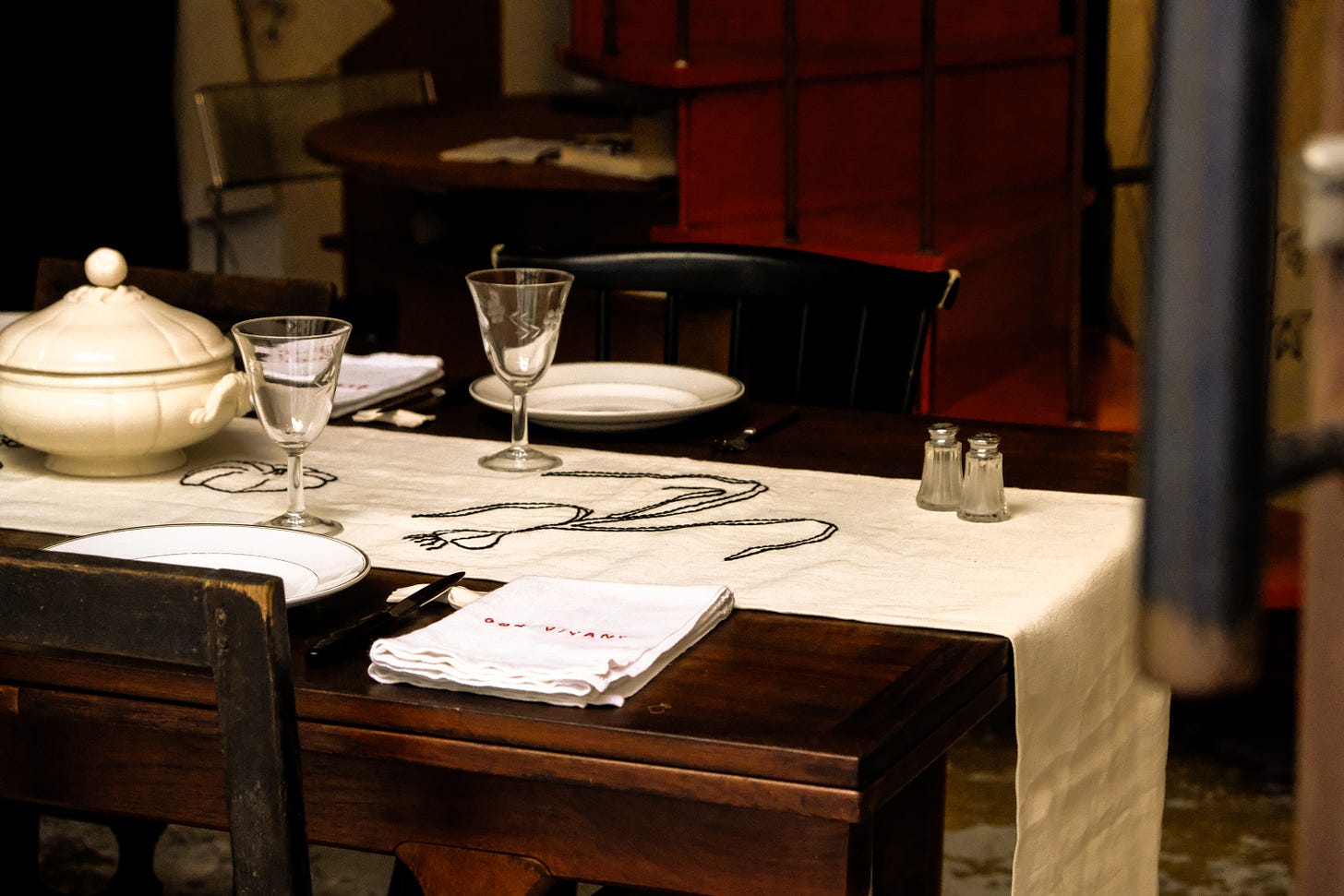People: Sarah Espeute of Œuvres Sensibles
An embroiderer in Marseille reminding of the power of beauty
🌹 This is a long-form piece — if you’re reading this on e-mail, click here for the full piece, ending with a Q & A with Sarah talking morning routines, finding inspiration and favourite spots in Marseille. Perhaps one for your slow Saturday morning. 🌹
I often think about the role that beauty plays in our lives, and increasingly so when there’s so much hardship and horror unfolding around the world. Artist and embroiderer Sarah Espeute has, amongst many inspiring influences, been a powerful reminder for me of the importance of beauty over this last year or so. A reminder that beauty is almost always more than something simply beautiful, pleasurable, pretty — that it might be what catches your eye, startles something within you, but on further thought and discovery, you come to realise that that’s just the beginning; there are the layers seeped in history and tradition, or the benefits to a society — from the community that the act of creating fosters to the transmission of information and skills from one generation to another. And in Sarah’s case, there’s also the nourishing power she shares of sitting with a needle, a thread and a piece of century-old linen and watching the vegetable you’re embroidering slowly appear, stitch by stitch. There’s nothing quite like it, especially not these days. And all of that comes back to beauty.
Sarah and I had this conversation when we first met, standing in her atelier in the south of France, in Marseille, an unsuspecting find in a small back street just off La Canebière, the main drag of the perfectly chaotic city — the softness and sensitivity of the atelier juxtaposed against the hard, hot and loud city sitting on the other side of the glass façade.
Œvres Sensibles embroidery atelier started, at its core, as simply an expression of Sarah; of her emotions, her sensibilities, and an expression of her creativity that was sincerely and intimately her. The atelier started in 2021 when Sarah made the move from Paris to Marseille to pursue her art in a place that she felt free to create, away from the pressures of trying to fit into a preconceived box, away from a certain kind of order that comes with pursing a career in the arts in Paris — it was a world she felt didn't fit into, and a world that didn’t have a job that fitted her. It was a move to Marseille five years ago that allowed her to bring her disciplines together through embroidery and create a job, a life tailored to her — her passions, her skills, her way of working.
It makes quite some sense, really. We’re fed a conventional path — school, university and a job that traditionally looks something like 9 to 5, Monday to Friday, a desk, four weeks off a year. Like anything conventional, wonderful for some, but bizarre to think that humans, as complex as they are, all want to go down this acutely specific path. Do as Sarah has, and build the job that feeds you, and that makes use of what you know, what you love, what you care about. For some reason — a difference in red tape and regulations, a lower cost of living, a value for the arts and creativity, and perhaps therefor, for non-conforming — this does seem to be more available to our generation in France than in Australia. Or maybe that’s simply a mindset.
Sarah had always had a compulsion to create, to express herself through creativity in her own way. In Paris, she ran a publishing house out of her Parisian-small apartment for four years, creating books using Riso printing — almost a digital screen printing technique. Having learned embroidery at school in Arles, where Sarah grew up, she was comfortable with a needle and ultimately, brought these two forms of illustrating together through her embroidery. “A piece of linen is like a piece of blank paper,” Sarah tells me the day I visit, a September morning almost exactly one year after having met the artist.
The more tome I’ve spent in the world of embroidery – whether through sitting next to my grandmother on the sofa learning her fabulous embroidered bees, flipping through my great grandmother’s embroidery books from 1923, coming across artists on social media or through visits to Sarah’s atelier – the more I’ve come to learn just how diverse embroidery can be, it being an intimate expression of each person’s creativity. Sarah’s pieces are made up mostly of single-line embroidery, stiched using a backstitch, the simplicity incredibly striking. Sarah tells me that it’s with this line, these blank pieces of linen, that you can tell a story – a story of emotions, of sensibilities. These pieces are a poetic expression of Sarah, of a story she wants to tell, suspending a moment in time, and her hope for her pieces are for them to go on to be part of other people’s stories through creating moments around their tables.
Sarah’s art revolves around every day objects, and the idea that these objects give more than their function — the marriage of beauty and function. We spoke of this, the day I had knocked on the large glass window of the atelier — my curiosity compulsion taking over. Sarah opened the door with a warm smile and proceeded to show me through her space, laying out large table cloths, one after the other, each one unique with hand-embroidered designs of Sarah’s.
We spoke about how each item in our lives is an opportunity for pleasure, for beauty, for creating a little joy within us — just because they’re functional objects doesn’t mean they can’t too be a pleasure. And really, it’s these everyday items and objects that are deeply woven into our daily lives, that we touch every morning, that we look at every night, that should be beautiful, should ignite an emotion within us.
Most of Sarah’s pieces are created using a white, or cream, linen. When I first met her, and when she first started out, these were pieces that Sarah would buy from brocantes or flea markets and antique dealers around France – pieces of French linen that were 100-150 years old, that were sitting folded in cupboards around the country, in need of a new home. I recall Sarah telling me that through the pandemic there were a lot of these fabrics for sale as older people passed, leaving their linen collections without an owner. This really sets the theme of working with a focus on being eco-responsible that runs through the brand. Sarah’s work, whilst creating beauty, is transmitting the art of embroidery from one generation to another through repurposing one generation’s linen to make it relevant to the next, simply using a needle, a thread, and her striking illustrations, or words that she feels connected to; a radish, a cabbage, a fish, a baguette, a red lobster, six dinner plates sitting in the spot of the diners around the table, or perhaps the words EMOTION, ROMANTIQUE, MOMENT embroidered on napkins in a rich red.

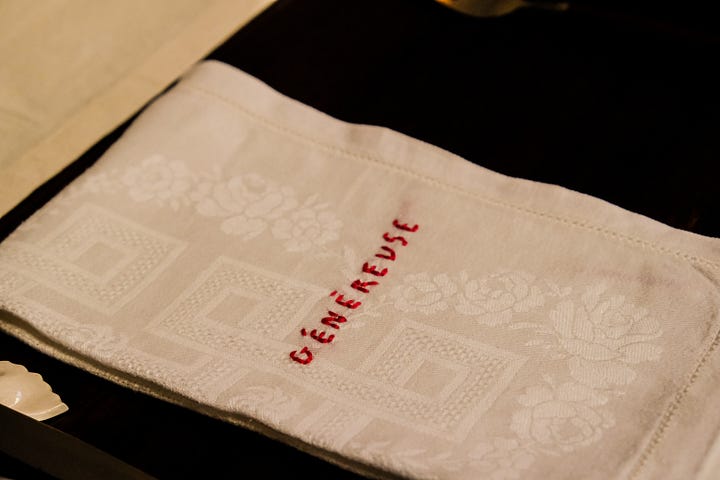
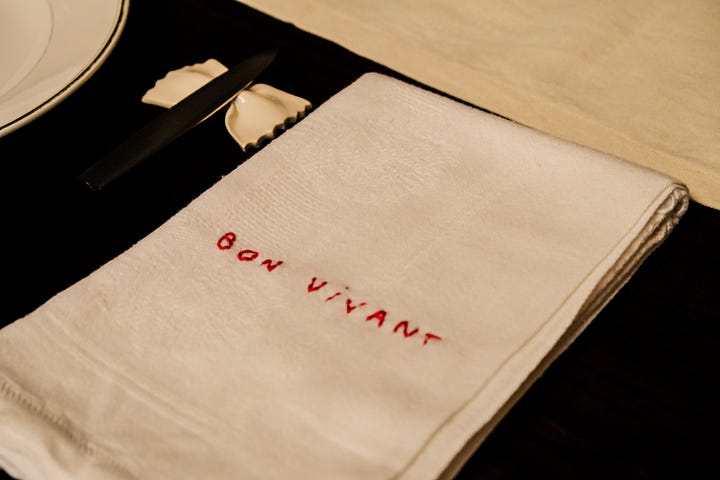

For sheets of linen with stains or that might be an off-colour, Sarah has started working with natural dyer, Couleur Garance in the Luberon who uses a plant die to turn these pieces from white to inky blue – a very Marseille tone. As the brand has grown, Sarah has taken on using a French-made linen to keep up with demand, acknowledging that not everyone values vintage linen in the same way, giving you the option when you purchase a piece to choose between repurposed linen or a new linen.
Standing in Sarah’s atelier for the first time, I thought of the way Alice Waters speaks of ‘beauty as a language of care.’ I’ve heard her speak of this in relation to taking the time and effort to set the table for family or friends, the intentionality instantly showing a certain level of care you have for someone. I first read about this idea in Alice’s daughter’s book, Always Home, where Fanny Singer says that above all the brilliance that her mother is credited for (a lot, deservingly), it’s her emphasising the importance of beauty in one’s life that she holds to be the most important.
‘All of this amounts to an attitude toward living born of sensitivity to one’s surroundings, dedicated to care, to the slow, meaningful collection of objects …’ Fanny writes.
I remember instantly thinking back to these pages when I entered Sarah’s world. Sarah’s napery — from tablecloths to runners to napkins — are beautiful, yes, but they’re far more than that. They’re an encouragement and a reminder to take a moment to set your table, to think about adding a layer of beauty to your meal; an encouragement to slow down; a reminder that it’s not just a meal, it’s a moment to gather, to talk, to connect. To me, it’s a language of care, but further to that, it’s a language of respect for the food that’s been grown, produced and cooked to feed you in that moment. As with each stitch of Sarah’s, each ingredient has been added with thought and time.
And then there’s the carrying of tradition from one generation to another, making an art form relevant to a whole new generation. Perhaps for some, we associate embroidery with our grandmother’s perfect roses sitting pretty on a facecloth or a daisy on a lace doily. Sarah has taken this tradition and, through combining it with her perspective and sensibilities, she’s caught the attention of all of us, helping us to understand and appreciate our grandmother’s work in a new way, and inspiring to carry on an art form that could so easily disappear with a generation that’s all screens, no needles. For me, it has been so special to share this with my brilliant 93-year-old grandmother who has been embroidering since she was in her twenties.
“In her conception of interior objects, Sarah is also deeply attached to the notions of timelessness and transmission. In the robust and raw touch of an old linen or cotton sheet, lived experiences are immortalised, igniting imagination and awakening sensations.”
— Œuvres Sensibles
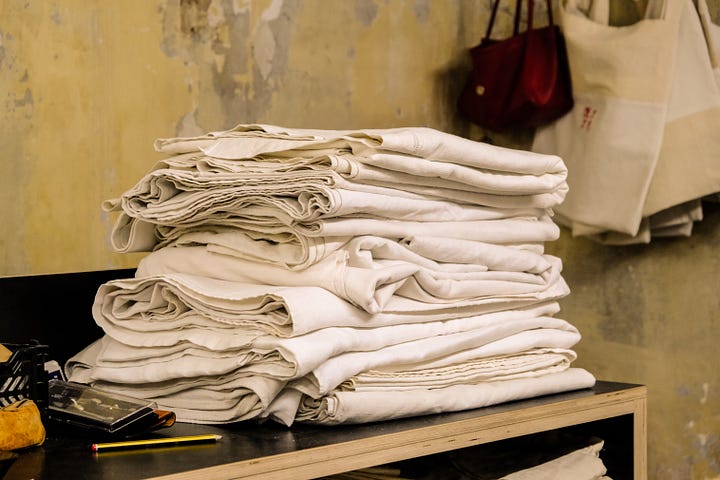

Marseille holds an important place in the history of embroidery globally. During the 17th century the port became the centre for trading of textiles largely due to the white, embroidered quilting that was being handcrafted by women in Marseille. These pieces, often bed covers with three dimensional embroidered patterns, seduced people all over Europe, and they came to be known as Marcella quilts, Marseilles work or piqué marseillais. My parents always had one of these quilts draped over their bed when I was a child, so getting to know the city and the history they come from has been fascinating.
Beyond history and traditions, and making the act of sitting around a table even more of a pleasure, Sarah has created quite the community through her beauty, through her embroidery. As the brand started to gain popularity, Sarah built a group of freelance creatives in Marseille (a city increasingly full of such people) that she teaches her style of embroidery to then pays them to embroider her sketched illustrations onto her pieces of napery. This structure is part of supporting a small, local economy, something that is increasingly rare in our Western capitalist societies. It was a highlight of my Marseille days — I arrived at the studio one afternoon, watched Sarah embroider the word EMOTION into a white napkin, following the sketched letters, then had a go myself. She sent me home with a calico bag full of three lots of napkins, a needle and some thread. I’d sit by the fire at night after a day of editing on my computer and stitch away. As my grandmother says, something just takes over you, and you can’t stop once you start. I’d often be up late into the night with that red thread and those white napkins.
I was working on Danielle and Libby’s book at the time, a book with a strong theme of cucina povera — an Italian style of cooking that revolves around the idea of making something beautiful with simple, available ingredients, using whatever is found in your kitchen or garden. In Libby and Danielle’s words, ‘Its beauty and sophistication lie in the belief that no matter what you do or don’t have, you are going to eat well.’ I instantly felt a connection between this approach to food and Sarah’s approach to embroidery. Some stale bread, overripe tomatoes and olive oil and you have pappa al pomodoro; some century-old linen, a needle and some thread and you have a beautifully dressed table. It came to be a most wonderful collaboration between these brilliant women with one of Sarah’s tablecloths sitting strikingly on the cover of the book. An approach to food, whether it’s how you cook or how you dine, that embodied the entire act of eating. It felt whole.
I visited Sarah a year or so later to photograph her in her atelier. We chatted as wandered through her new space that’s set up as a showroom for her work but also as a space to hold dinners and events; we chatted as we wandered up the red, wooden spiral staircase; as we flipped through the books she published in her Parisian apartment those years ago; we chatted as we went out the door, onto the bustling street and into her atelier next door; as we met the women she works with – Emma on the loom, Clara on the sewing machine and Danaé on the computer; we chatted as I took Sarah’s portrait in front of her wall of linen, folded and sitting on shelves waiting for an illustration and a needle; as we wandered up the stairs to the loft where the large sewing table sits, home to the latest pieces the intimate team are working on.
It’s something I’ll think about forever, I’m quite sure – the role and value of beauty in our lives. Sometimes I look at something and feel sheer overwhelm because it’s just so beautiful, it’s something beyond words and beyond explanation. I read once that these moments get stored away in your mind for moments when life is less-than-beautiful. I like that.
Why put a beautiful table cloth on your table? Why light some candles? Why have a few special plates to eat your food off, or a piece of cutlery that’s a pleasure to hold? Well, because each of these objects spark something in you, whether you’re conscious of it or not – because of their beauty, and because of the story and the people behind each thing you touch, each thing you look at. Well, they do for me. They’re part of a sense of occasion, part of history, and they’re a reminder to sit down, slow down and linger around the table. They’re far more than objects, they’re far more than something beautiful. We’re lucky, those of us who have a table to dress and lovely food to eat, and the world is a softer place to be with all of these seemingly small things, seemingly small moments, and I think the seemingly small that create a moment of pleasure are an increasingly important thing in our lives.
Sarah Espeute of Œuvres Sensibles: a lesson in following your heart, your desire to create — if you don’t fit into what’s there, build it yourself. And a reminder of the power and of the importance of beauty in our everyday lives.
IN CONVERSATION WITH SARAH
What’s your morning routine?
A shower, breakfast with tea and toast, then I hop on my bike to get to my atelier.
What surprised you about your move to Marseille?
The color of the sky, very blue; the mix of people; the mess but that you have to see
in a comical way; a feeling of being on vacation; nice people and not nice people
when you don't know them yet.
Is where you are now in any way how you envisioned your life as a younger you?
I think so, I've always had this desire to express myself freely and to be able to show
it to others, to seek some form of recognition. I'm a perfectionist, and often that's not
enough for me, so it pushes me to go further.
What are you reading?
I don't read often, I can't fit it into my day, it's ridiculous but I feel like I'm wasting my
time. And when I do get into bed, it's only to fall asleep straight away!
I always feel the need to enjoy my time with things that inspire me, and that means
visual things, so I sometimes leaf through magazines at the weekend, or
second-hand interior design books on my coffee table. I also regularly read pages
of biographies of women artists from the catalog of the ‘Elles font l'abstraction’ from
an exhibition at the Centre Pompidou museum.
What are you watching?
There are a lot of films I love. Eric Rohmer's films, for example, I've seen a lot of
them in a row. I love this lightness of life, all philosophical. The dialogues are
fascinating, as are the settings, which are very inspiring. I also love Agnès Varda,
from the nouvelle vague, for her photographic eye for the insignificant, and Pedro
Almodóvar's feminine, flamboyant cinema, where there's always a tragedy and a
love story.
What are you working on right now?
I'm working on several very different things: developing my brand with a new range
of products in printed illustration, but also on more artistic furniture combining my
paintings, which I'll have the opportunity to showcase at an exhibition in May in
Lectoure. I oscillate between business girl and artist woman, it's very strange!
A few of your favourite spots in Marseille?
For a quick bite to eat:
Bouillabaisse Turfu
Razzia
Limon
To eat:
Catherine
Les Eaux de Mars
Limmat
Couscous sur le Pouce
Shanghai Kitchen
Robato
To drink wine and share plates:
Carnage
Mercato x WINESUCKER
To drink wine at the counter:
La Passerelle
For breakfast and coffee:
La brûlerie Moka
To drink and dance (on weekends):
Twali
For shopping :
Emmaüs Colbert
Maison Empereur
Les friperies du cours julien
To visit exhibitions:
La vieille Charité (musée)
Le Mucem
To go to the cinema:
La baleine (pour aller au cinéma)
Les Variétés
Pour se baigner [to swim]:
La baie des singes
La anse de la fausse monnaie
Merci Sarah, merci beaucoup. 🌹
For napery commissions, including tailor-made pieces, or to place an order with Sarah (she ships globally), get in touch via her website here, and peruse her work on Instagram here. Sarah’s collection has grown to bedding and pillows and she’s currently working on printed illustrations and collaborations in furniture. A woman to watch.
A joy to have you here, always.
H.




